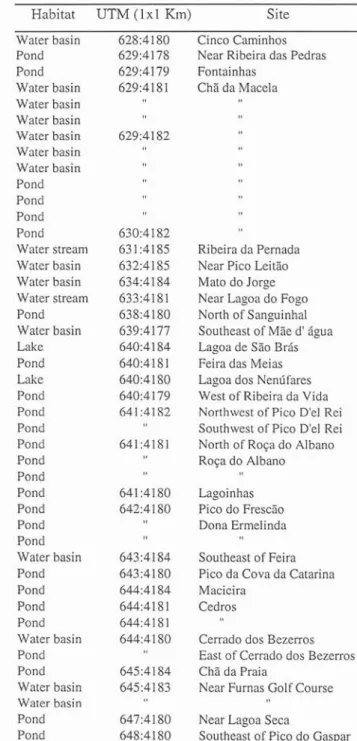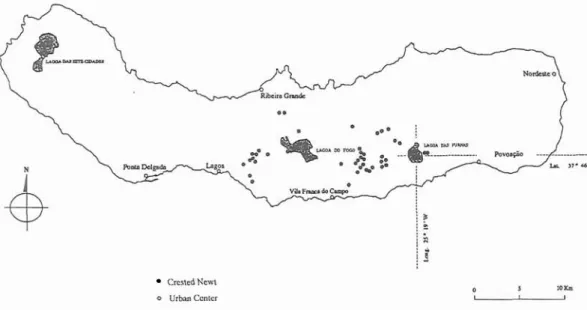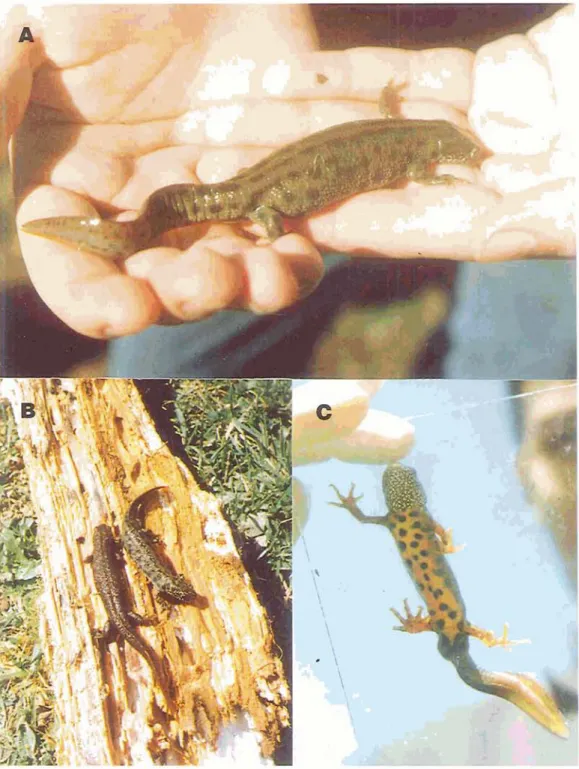DISTRIBUTION
OF
TRITURUS
CRISTATUS
CARNIFEX
(AMPHIBIA:
SALAMANDRIDAE) ON S ~ O
MIGUEL ISLAND (AZORES)
E.
MACHADO,
L.
SILVA
&R.
ELIAS
MACHADO, E., L. SLVA & R. ELIAS 1997. Distribution of Triturus cristatus
camifex (Amphibia: Salamandridae) on SBo Miguel island (Azores). Arquipe'lago. Life and Marine Sciences 15A: 97-102. Ponta Delgada. ISSN 0873-4704.
This is the first study of the ecology of Triturus cristatus on Slao Miguel island (Azores), where it was introduced in the early 1900's. Morphological traits of the Azorean population are those expected for the subspecies T. cristatus carnifex, namely relatively smooth skin, reduced white punctuation, orange ventral surface with large, well defined dark spots, a vertebral yellow line in the females and a conspicuous dorsal crest in males. T. cristatus carngex was fou?d at 45 sites in the central part of S b Miguel Island, from the western foot of Serra de Agua de Pau to Furnas, between 200-700 m of altitude, mainly in ponds and water basins associated with pastures. The success of this species is related to the expansion of pasture land, so that its conservation, in the Azores, is greatly dependent on cattle raising practices.
MACHADO, E., L. SLVA & R. ELIAS 1997. Distribui@o de Triturus cristatus
carnifex (Amphibia: Salamandridae) na ilha de SHo Miguel (Asores). Arquipe'lago. Ci&ncias Bioldgicas e Marinhas 15A: 97-102. Ponta Delgada. ISSN 0873-4704. Este
t
o primeiro trabalho sobre a ecologia de Triturus cristatus na ilha de Slao Miguel (A~ores), onde foi introduzido no i n 5 0 deste sCculo. A popula@o aaoreana apresenta a pele relativamente Lisa, com pouco ponteado branco, ventre alaranjado, com grandes manchas cinzentas-escuras, bem definidas, e uma linha vertebral amarela nas fgmeas, caracteristicas que a identificam como a subespkie T. cristatus carnifex. Foram mapeados45 locais onde T. cristatus carnifex foi encontrado na zona central da ilha de Sb Mlguel, entre o sop6 ocidental da Serra de Agua de Pau e a freguesia das Furnas, entre os 200 e os 700 m de altitude, sobretudo em charcos e bebedoiros, em pastagens. 0 sucesso desta espkcie est6 relacionado com o aumento da 6ea dc pastagem, pelo que a sua conserva~b, nos Asores, est8 grandemente dependente da actividade pecuAria.
Emanuel Machado, Amigos dos A~ores, PT-9500 Ponta Delgada, A~ores, Portugal. - Luis Silva (e-mail: silva@al$uac.pt) & Rui Elias, Universidade dos Acores, Departamento de Biologia, PT-9500 Ponta Delgada, A~ores, Portugal.
INTRODUCTION
In the Azores two species of amphibians, both
introduced, are found, Rana perezi (Seoane,
1885) (Ranidae) and Triturus cristatus (Laurenti,
1768) (Salamandridae) (ULFSTRAND 1961 ;
SVANBERG 1975). Individuals of Salamandra
salarnandra (Linnaeus, 1758) (Salamandridae) and Pleurodeles waltl (Michahelles, 1830) (Salamandridae), also introduced, have been
occasionally collected, and the possibility that these amphibians belong to natural populations on Sio Miguel island is now being evaluated. The green frog, which was probably introduced in
1820 (CHAVES 1949), is presently found on all the
islands of the Archipelago. In 1922 the crested newt was already present in SBo Miguel, the only Azorean island where it is presently found
(SVANBERG 1975), but the site and date of
species does not occur in the Iberian Peninsula (ARNOLD & BURTON 1987), so the Azorean population is probably derived from an undetermined European population (MACHADO 1992). To our knowledge, this species is not present on other Macaronesian islands (KUNKEL
1976; ANONYMOUS 1990), and no ecological or biological research has previously been carried out on the Azorean population.
Since T. cristatc~s is a threatened species, included in Appendix I1 of Bern Convention, concerning the protection of wildlife and of the environment in Europe (ANONYMOUS 198 1), the success of the Azorean population might be regarded as very interesting with respect to its habitat use and the protection of suitable habitats on the continent. It would likewise be important to d~termine in more detail the causes of this success in the Azores.
The objective of this work was to map the distribution of T. cristatus on SBo Miguel island and to confirm the identification of the subspecies
T. c. carizifex.
MATERIAL AND METHODS
SBo Miguel is a volcanic island with an area of about 750 km2, of which 40% of the surface has been turned to pasture. More than thirty small lakes are present, of different sizes, depths and surroundings. Many has became eutrophic due to direct contact with pastures and the associated input of nutrients. Many lakes are surrounded by
Cryptonzeria jczporzica woods, many more by pastures and some by endemic plant communities. In general, the vegetation associated with lakes in the Azores has been described as the alliance
Litorello-Eleocharioiz (SJOGREN 1973). Many
ponds and water basins are also found, associated with cattle farms. Mean annual temperature in SBo Miguel varies from 12°C at 550 m to 17°C at 70 m of altitude, and rain fall from 1020 to 2309 mmlyear (INMG 1991).
Since 1994 a thorough survey of ponds, lakes and water basins all around the island has been undertaken. Specimens of T. cristatus were searched by dragging a net close to the bottom or through the water column for adults and larvae, respectively, and by direct observation of eggs in submerged vegetation. The position of each positive site was recorded on a 1:25000 map (Serviqos Cartograficos do ExCrcito). Altitude and type of habitat was noted. The UTM (Universal Transverse Mercator) 1x1 krn grid was used to locate each site.
CONFIRMATION OF THE SUBSPECIES
Several adults were captured and the external traits analysed, in order to check the validity of the attributed subspecies, according to the characteristics given by ARNOLD & BURTON (1987).
RESULTS
T. cristatus was found at 45 sites in the central part of SBo Miguel island, from the western foot of Serra de Agua de Pau to Furnas (Table 1; Fig. I), mainly in ponds (60 %) and water basins (31 %) (Fig. 2). Almost 40 % of the sites where T. cristatus was found were located between 500 and 600 m of altitude, and 60% between 400 and 600 m of altitude. CONFIRMATION OF THE SUBSPECIES
Adults showed reduced white punctuation at the flanks, and the ventral surface was generally orange with large, well defined, dark spots. A vertebral yellow line was generally present in the females (Fig. 3). These traits are in agreement with what could be expected for the subspecies T.
cristatus carnifex (ARNOLD & BURTON 1987). The typical crest of T. cristatus males has been found during the breeding season and also afterwards in males captured in water.
Table 1 DISCUSSION
Trit~ir~is cristcrtus sites on Sao Miguel island. in accordance
with the UTh4 system (co-ordinates of the upper left corner of each I x l km square are given).
Habitat UTM (1x1 Km) Site Water basin Pond Pond Water basin Water basin Water basin Water basin Water basin Water basin Pond Pond Pond Pond Water stream Water basin Water basin Water stream Pond Water basin Lake Pond Lake Pond Pond Pond Pond Pond Pond Pond Pond Pond Pond Water basin Pond Pond Pond Pond Water basin Pond Pond Water basin Water basin Pond Pond Cinco Caminhos Near Ribeira das Pedras Fontainhas
ChB da Macela
Ribeira da Pernada Near Pico LeitZo Mato do Jorge Near Lagoa do Fogo North of Sanguinhal Southeast of MBe d' dgua Lagoa de SBo Brds Feira das Meias Lagoa dos Nendfares West of Ribeira da Vida Northwest of Pico D'el Rei Southwest of Pico D'el Rei North of R o p do Albano R o p do Albano Lagoinhas Pico do Frescao Dona Ermelinda Southeast of Feira Pico da Cova da Catarina Macicira
Cedros
Cerrado dos Bezerros East of Cerrado dos Bezerros Cha da Praia
Near Furnas Golf Course Near Lagoa Seca
648:4180 Southeast of Pico do Gaspar
It is not known to us how and by whom T.
cristatus carizifex was brought ot the
Azores from the European continent. This subspecies has a wide distribution, including northern Italy, north-eastern parts of the Alps, part of Austria, and northern ex-Yugoslavia.
Cattle raising may have been a decisive factor in the establishment of
T.
cristatus carnifex on SBo Miguel island,
by making available an adequate and widespread habitat
-
ponds and water basins. In fact, the altitude range of T.cristatus carnifex, from 200 to 700 m,
covers almost completely the distribution of pastures (OLIVEIRA 1989) and a, orees with earlier observations by MACHADO (1992). On the other hand, at higher altitudes, higher humidity and rain fall are expected, which may favour the existence of amphibians.
The type of habitats occupied, mostly water basins and ponds, with low water flow, is in accordance with those found in Europe (ARNOLD & BURTON 1987). However, the majority of these habitats are artificial, and are used as watering places for cattle. The destruction or replacement of those habitats, by other structures, in order to improve the control of brucelosis and fasciolosis, for example, may threaten the existence of T. cristatus
carnifex on S5o Miguel.
In some Azorean lakes, newts may be predated by Micropterus salrnoides. In
fact, the predation of eggs, larvae and adults, by introduced fish, is a potential limiting factor of T. cristatus carnifex
population on SBo Miguel.
Water quality, for example pH (DOLMEN 1988), may also affect the distribution of the crested newt. For example, at Lagoa do Areeiro, located in the zone were T. cristatcis carnifex is more frequent, this species was not found, despite the presence of potential food, like benthic Crustacea, Cladocera and
Crested New1
0 J 10%
o Urban Ccnter I I
Fig. 1. Sites where Triturus cristatus carnifex was found on Stio Miguel island (Azores).
Water basins
0 100 200 300 400 500 600 700 800
Altitude (m)
Fig. 2. Distribution of Trirurus cristatus carngex on SLo Miguel island, in accordance with altitude (A) and the habitat (B1 (from a total of 45 sites).
Copepoda (DOLMEN & KOKSVIK 1983), and the ACKNOWLEDGEMENTS absence of fish populations, perhaps due to strongly
acidic water (pH = 5). We would like to thank AssociaqZo We can conclude that the success of T, cristatus EcolBgica/Amigos dos Aqores and Centro de
canzifex on the Azores, is related to the expansion ConservaqSio e ProtecqZo do Ambiente of pasture land and associated water reservoirs and (Universidade dos Aqores). The manuscript was that its conservation is greatly dependent, between improved by comments and corrections from two other factors, on cattle raising practices. anonymous reviewers.
Fig. 3. Some morphological traits of Trirurus cristatus cara#ex. (A) Female with its vertebral yellow line; (B) Female (left) and male on a wooden log which they used as a shelter; (C) Ventral view of a male, with its orange colour, and with large well defined, dark spots.
REFERENCES
ANONYMOUS, 198 1. Convenqiio Relativa & Protecqo da Vida Selvagem e do Ambiente Natural da Europa, DiArio da Repdblica, l a Sdrie, NO1 67 de 2317. ANONYMOUS, 1990. Livro Vermelho dos Vertebrados
de Portugal, Vol. I, Mamiferos, Aves, RCpteis e Anfibios. Sewiqo Nacional de Parques, Resewas e Conservaqtio da Natureza, Lisboa. 219 pp.
ARNOLD, E.N & J.A. BURTON 1987. Guia de Campo de
10s Reptiles y AnjZbios de Espaiia y de Europa.
Ediciones Omega. Pp: 43-46.
CHAVES, F. 1949. Introduqlo de algumas especies zool6gicas na ilha de Siio Miguel depois da sua descoberta. A~oreana 4 (4): 325-342.
DOLMEN, D. 1988. Coexistence and niche segregation in the newts Triturus vulgaris (L.) and Triturus
cristatus (Laurenti). Amphibia-Reprilia 9: 365-374.
DOLMEN, D. & J.I. KOKSVIK 1983. Food and feeding habitats of Triturus vulgaris (L.) and T. cristatus
(Laurenti) (Amphibia) in two bog tarns in central Norway. Amphibia-Reptilia 4: 17-24.
INMG (INSTUUTO NACIONAL DE METEOROLOGIA E
GEOF~SICA) 1991. 0 clima de Portugal. Normais climatol6gicas dos A ~ o r e s correspondentes a 1951- 1980. Fasciculo XLIX, Vol. 5
-
5a Regiiio. Lisboa. 48 PP.KUNKEL, G., 1976. Biogeography and Ecology in the
Canary Islands. W . Junk, The Hague. 5 1 1 pp. MACHADO, E. 1992. 0 trittio de crista em S5o Miguel.
Vidrilia 10: 4-5.
OLIVEIRA, J.N.B. 1989. A pastagem permanente da ilha de Siio Miguel (A~ores): estudo fitossociol6gico e primeia abordagem do ponto de vista agron6rnico. Tese de Doutoramento, universida.de dos Aqores, Ponta Delgada. 366 pp.
SJOGREN, E. 1973. Recent changes in the vascular flora of the Azores. Memdrias da Sociedade Broteriana 22: 1-453.
SVANBERG, I. 1975. The warty newt (Triturus cristatus) of the Azores. Bocagiaaa 40: 1-2.
ULFSTRAND, S. 1961. On the vertebrate fauna of the Azores. Boletim do Museu Municipal do Funchal 14: 75-86.


